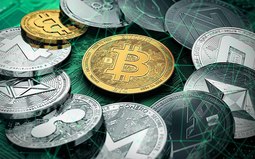Posts tagged #5
-
Exclusive interview with Rick Nucci, Co-founder and CEO of Guru, a Philadelphia-based tech innovator challenging Silicon Valley norms.
Since 2013, Guru has revolutionized enterprise information accessibility, raising $71M and becoming a leader in AI-based search and knowledge platforms. Rick, with over 20 years in software development and success with Boomi (acquired by Dell), brings invaluable experience to Guru.
In this interview at Accel's office, Rick discusses Guru's new AI tool and shares insights on AI advancements and workplace culture as the company turns 10. His expertise in startups, SaaS, and cloud computing offers crucial perspectives on the future of corporate information management and AI utilization.
Discover how Guru's success story and Rick's leadership philosophy, including "Don't take yourself too seriously," are shaping the future of AI and knowledge management.
Guru : https://www.getguru.com
---
Timeline
01:52 2x Founder's 5 Profound Lessons for Startup Success
02:46 Insight#1 Lessons from selling a startup at 24
07:25 Insight#2 Growth secrets from launching two successful startup
10:34 Insight#3 How early-stage startups can win their first customers
14:04 Insight#4 Finding PMF and scaling rapidly: A founder's guide
16:43 Insight#5 Why now is the best time to become the best
---
Today’s video is sponsored by #Paragon :
Building an AI SaaS app? Ingest context (structured and unstructured data) from and automate tasks across the hundreds of 3rd party apps and files your customers use, with 70% less engineering using Paragon.
Join leading AI B2B SaaS product & engineering teams that rely on Paragon as their ingestion engine and connector layer for RAG and agentic workflows.
- Link: https://useparagon.com/eo-ai
-----
EO stands for Entrepreneurship & Opportunities. As we're looking to feature more inspiring stories of entrepreneurs all over the world, don't hesitate to contact us at [email protected]
#Guru #RickNucci #Startup #AI #B2B-
- 1
Francisco Gimeno - BC Analyst Rick Nucci, co-founder and CEO of Guru, discusses the current state of AI and its impact on the startup landscape in this YouTube video. What he says is just common sense for anyone involved: the tradicional startup play book has changed and will continue changing and very fast in the AI space. Big companies can even see AI as a threat to their business model, so the fight to “be” in the AI space as a startup is a continuous and very rapid almost daily challenge wile trying to maintain a stable business and trying to solve real customer problems through new products (products adapted to market, where the AI is increasingly important). So, Nucci (who also advertises his own solution) emphasises the need for adaptation to this new AI environment looking for sustainable growth. In fact, anyone who doesn’t adapt to this, is going to become the new Kodak, or Blockbuster. Can we afford in these times to dilly dally and deny that AI is not in the next future, but it’s already now the biggest change and challenge everywhere.- 10 1 vote
- Reply
-
-
📚 My Free Resource Hub & Skool Community: https://b.link/hg2e3ggt (Check “Youtube Resources” tab for any mentioned resources!)
🤝 Need AI Solutions Built? Work with me: b.link/qv62vqy6
📈 Find out how we help industry experts and entrepreneurs build and scale their AI Agency: https://b.link/5ozq7mov
⚒️ Build AI Agents Without Coding: https://agentivehub.com/
Since moving to Dubai and living here for two years now, I've experienced a lot. So in this video I share the real pros and cons of living in Dubai as an entrepreneur and AI Automation Agency (AAA) owner. I'll also answer the question you might have of 'should I move to Dubai?'
Timestamps
0:00 - What We’re Covering
0:43 - My Experience
2:34 - Pro #1
3:08 - Pro #2
3:29 - Pro #3
3:58 - Pro #4
4:23 - Pro #5
4:48 - Pro #6
5:12 - Pro #7
5:46 - Pro #8
6:14 - Con #1
6:51 - Con #2
7:24 - Con #3
7:56 - Con #4
8:29 - Con #5
8:52 - Con #6
9:39 - Con #7
10:28 - Con #8
12:08 - Con #9
12:23 - Who SHOULD Move to Dubai?
13:13 - Who SHOULDN’T Move to Dubai?
14:41 - Bonus Pro-
By
 Admin
Admin - 0 comments
- 2 likes
- Like
- Share
-
By
-
Solana Saga Chapter 2 holders were gifted with two new airdrops this morning. Meanwhile, Apple continues to struggle due to it's monopolistic practices and China's increasing innovation. Meta has announced that its Meta Horizon OS will no longer be exclusive to its Quest headsets (such as the incredible Meta Quest 3), and this might be the most important news we’ll see in the XR space this decade.
PRE-ORDER Saga 2 NOW! ➜ https://solanamobile.com/refer/paulba...
~This episode is sponsored by Tangem~
Tangem ➜ https://bit.ly/TangemPBN
Use Code: "PBN" for Additional Discounts!
00:00 intro
00:20 Sponsor: Tangem
01:06 Solana Congestion Over?
01:34 Upgrade in May
01:59 Solana Saga Chapter 2
02:23 $MANEKI Airdrop
02:49 NFT Airdrop
03:09 Apple Tax vs Airdrops
04:44 Apple is Dead Money
05:32 iPhone China Sales Plummet
05:46 Tim Cook Moves To Indonesia
06:27 Solana Chat
07:03 SolChat on Helium
07:53 Apple Lagging in AI
09:12 Meta Opens it's OS
11:19 Apple Panic Event
12:06 Meta NFT Marketplaces Coming
13:20 Open Storefront & SideQuest
14:00 Revomon Listing on Meta Quest
14:34 $SOMO PalWorld Killer?
15:55 Secure Element Chip
16:15 Jamie Dimon vs Apple
17:43 Government vs Data Privacy
20:30 Solana Email vs Gmail
21:13 $CHAT & $MAIL
21:45 1SOL or $1,000?
22:26 Solana Price Prediction
23:00 outro
#Crypto #Solana #apple
~Solana Saga Airdrop #5!🚨Apple vs Meta War Heats Up🔥~
⎺⎺⎺⎺⎺⎺⎺⎺⎺⎺⎺⎺⎺⎺⎺⎺⎺⎺⎺⎺⎺⎺⎺⎺⎺⎺⎺⎺⎺⎺⎺⎺⎺⎺⎺⎺⎺⎺⎺⎺⎺⎺⎺⎺⎺⎺⎺⎺⎺⎺⎺⎺⎺⎺⎺⎺⎺⎺⎺⎺⎺⎺⎺⎺⎺⎺⎺⎺⎺⎺⎺⎺⎺⎺⎺⎺⎺
Become a Diamond Circle Member FREE! ➜ https://bit.ly/PBDiamondCircle
Connect With Paul Barron Direct ➜ https://bit.ly/pbminnect
Subscribe on YouTube ✅ https://bit.ly/PBNYoutubeSubscribe
Twitter 📱 http://bit.ly/PBNtwitter
Market Sentiment Index ➜ https://bit.ly/MarketSentimentIndex
Trade with LuxAlgo For The Best Market Indicators ➜ https://bit.ly/LuxPaul
Looking for the best tax havens for Crypto? Free Month with iTrust Capital - Use PROMO CODE - PAUL BARRON https://rebrand.ly/PAULBARRON
-
By
 Admin
Admin - 0 comments
- 0 likes
- Like
- Share
-
By
-
Why is the local club scene dying? A residency in one of these used to be a tried-and-tested route to DJing success. But times are hard! Why? We investigate in today's show...
⚡ TIMESTAMPS ⚡
0:00 Intro
2:39 What clubbing means to us
3:21 Why are nightclubs shutting down?
5:17 Phones are killing the vibe (Reason #1)
7:13 Everyone has access to the same music (Reason #2)
9:00 Big events and festivals have taken over (Reason #3)
10:37 Economic downturns (Reason #4)
11:51 Gentrification of city areas (Reason #5)
13:52 The rise of online connections (Reason #6)
14:40 What's the answer?
27:03 Hercules DJControl Inpulse T7 winner announcement
👉 Subscribe and tap the 🔔 to get notified about new videos on how to DJ
👉 Want our free DJ training and guides for beginners? Sign up here: https://www.digitaldjtips.com/join
Want more DJ info?
▶ Take an online DJ course: https://djtips.co/courses
▶ Read "Rock The Dancefloor!": https://www.digitaldjtips.com/rock-th...
▶ Get DJ Gear reviews & news: https://www.digitaldjtips.com/
▶ Join The Global DJ Network: https://djtips.co/global
▶ Like us on Facebook: / digitaldjtips
/ digitaldjtips
▶ Follow us on Instagram: / digitaldjtips
/ digitaldjtips
▶ Follow us on TikTok: / digitaldjtips
/ digitaldjtips
▶ Follow us on Twitter: / digitaldjtips
/ digitaldjtips
▶ Subscribe to our newsletter: https://www.digitaldjtips.com/join
#Nightclubs #Clubbing #MusicIndustry #DJTips #DJing #Tech #Gear #Gigs #DJs #DJSchool #DigitalDJTips-
By
 Admin
Admin - 0 comments
- 0 likes
- Like
- Share
-
By
-
Rogue Putin is the biggest risk of 2023. Here are the other 9, explained by global political expert Ian Bremmer.
Subscribe to Big Think on YouTube ► https://www.youtube.com/channel/UCvQE...
Read more of Eurasia Group's top risks for 2023 ► https://www.eurasiagroup.net/issues/t...
Today’s world is facing large-scale problems, from wars to water shortages to a looming global recession. It's not easy to accurately conceptualize the risks posed by these issues. This is especially true when people on social media or in the news inaccurately overblow certain problems and discount others, or when problems become so emotionally or politically charged that it seems impossible to work toward a solution.
That’s one reason why the Eurasia Group publishes a detailed analysis of the top risks facing our world each year. As political scientist Ian Bremmer explains, the top risks for 2023 include water stress, inflation shockwaves, and the uncertain future of a “rogue Russia.”
Bremmer is the founder of Eurasia Group, an organization that for 25 years has been using political science to help investors and corporate decision-makers better understand how politics impact risks and opportunities in foreign markets.
0:00 What is the global risk report?
1:17 #10 Water stress
2:37 #9 TikTok boom
3:43 #8 Divided States of America
4:54 #7 Arrested global development
6:15 #6 Energy crunch
7:15 #5 Iran in a corner
8:47 #4 Inflation shockwaves
10:30 #3 Weapons on mass disruption
12:08 #2 Maximum Xi
14:18 #1 Rogue Russia
Read the video transcript ► https://bigthink.com/series/the-big-t...
----------------------------------------------------------------------------------
About Ian Bremmer:
Ian Bremmer is the president and founder of Eurasia Group, the leading global political risk research and consulting firm started in 1998. Today, the company has offices in New York, Washington, and London, as well as a network of experts and resources around the world. Bremmer has authored several books, including the national bestseller The End of the Free Market: Who Wins the War Between States and Corporations?
----------------------------------------------------------------------------------
Read more of our stories on 2023 predictions:
Why 2023 will be “the year of mixed reality”
► https://bigthink.com/the-present/2023...
The case for global optimism continues to grow in 2023
► https://bigthink.com/the-present/2023...
The 12 most exciting space missions of 2023
► https://bigthink.com/hard-science/202...
----------------------------------------------------------------------------------
About Big Think | Smarter Faster™
► Big Think
The leading source of expert-driven, educational content. With thousands of videos, featuring experts ranging from Bill Clinton to Bill Nye, Big Think helps you get smarter, faster by exploring the big ideas and core skills that define knowledge in the 21st century.
► Big Think+
Make your business smarter, faster: https://bigthink.com/plus/
----------------------------------------------------------------------------------
Want more Big Think?
► Daily editorial features: https://bigthink.com/popular/
► Get the best of Big Think right to your inbox: https://bigthink.com/st/newsletter
► Facebook: https://bigth.ink/facebook
► Instagram: https://bigth.ink/Instagram
► Twitter: https://bigth.ink/twitter-
By
 Admin
Admin - 0 comments
- 0 likes
- Like
- Share
-
By
-
Not only is impatience unpleasant, but it’s also pointless. Impatience is the unwillingness to live life at the pace it actually happens; we wish for the universe to bend to our will. We want things now. We want things to change in an instant. But in reality, external circumstances are not up to us: no matter how much we wish that to be the case. Patience, the opposite virtue, is based on the acceptance of what is.
Video: Why Patience is Power | Priceless Benefits of Being Patient
Support the channel:
✔️ PayPal: https://www.paypal.me/einzelgangerco
✔️ Patreon: https://www.patreon.com/einzelgangster
✔️ Bitcoin: 3HQnEz1LQ4G6dqN2LdZgzc7qoJjJCyWjTC
(Donated BTC and want in the credits? Send me an email with the amount/address)
🎞️ Animations and thumbnail art by Munkaa:
 / jus7y
/ jus7y
Book: Loose! (affiliate links):
📘 Paperback: https://amzn.to/3QVfrqM
💻 Ebook: https://amzn.to/3qStDX0
Book: Stoicism for Inner Peace (affiliate links):
📘 Paperback: https://amzn.to/3wB9iHb
💻 Ebook: https://amzn.to/2RdjbKV
Book: Unoffendable (affiliate links):
📘 Paperback: https://amzn.to/2RJYfti
💻 Ebook: https://amzn.to/35e23a5
Merchandise:
🛍️ Shop: teespring.com/stores/einzelgangerstore
🛍️ Merchandise design by Punksthetic Art:
 / JRStoneart
/ JRStoneart
#patience #innerpeace #buddhiststory
00:00 - Intro
02:05 - Patience & impatience
03:27 - Benefit #1
05:36 - Benefit #2
06:57 - Benefit #3
08:20 - Benefit #4
11:08 - Benefit #5-
Francisco Gimeno - BC Analyst Patience is a virtue lauded by humans since the beginning of our species, in religions, philosophies, ethics and in any transactional process where humans need to just stop, wait, and go with the flow, as to be inpatient is basically useless, pointless. This podcast reminds us how trying too fast too hard is most of the times a crime against rational thinking, and causes suffering which is a Buddhist teaching. Anger, fear, anxiety comes from not being patience, and as any Stoic would say, from a lack of self control. In short living in a world where things happen NOW, and social media is basically playing with impatient and the now, we have to control how we live our humanness, been full aware on how patience is the foundation of many other human's virtues. When we forget the path to our destination, focusing too much on the latter, being inpatient, we may get lost and choose the easy but pointless path instead of the difficult but needed path. We who write about new tech, the blockchain and crypto know very well how lack of patience makes people loose their money, companies go up and bust in a short time. Only those who slowly build, step by step, practicing the patience, looking at the big picture, listening the real trends and not the latest wonder in the crypto arena are building powerful companies. Remember then, patience you must have, my young Padawan!
-
-
From simply playing games to throwing thousands of dollars to own properties, here is a list of top ways to make money in the metaverse!
Isn’t your news feed full of metaverse-related news? Since Mark Zuckerberg announced the focus of his new product towards the Metaverse, it has surged in popularity and made waves in the digital world. As a result, most of the industry's focus has shifted towards offering passive income opportunities through different metaverse-based products. If you are still confused about what is possible in the metavers and how to make money in it, this video is for you!
00:00 - How to Make Money in the Metaverse?
01:04 - #1 Play-to-earn Games
02:09 - #2 Travel and Tourism
02:50 - #3 Online Concerts and Virtual Parties
03:35 - #4 eCommerce
04:08 - #5 Trading Virtual Property
06:03 - #6 Trading Metaverse Tokens
06:45 - #7 Trading Digital Art
07:13 - #8 Advertising
07:42 - Best Platforms to Invest in the Metaverse
07:52 - Axie Infinity
08:19 - The SandBox
08:49 - Decentraland
09:26 - How Is Metaverse Booming at the Moment?
🔔 From crypto news, to market moves, and to educational how to videos. If you want something more than just hype and to actually learn about crypto, make sure to hit the subscribe button right now and turn on notifications to not miss out on new videos!
🔵 Coin Market Cap is the world's most-referenced price-tracking website for cryptoassets in the rapidly growing cryptocurrency space. Its mission is to make crypto accessible all around the world through data and content.
📲 Download our app!
IOS : https://apple.co/3dOkokH
Android : https://bit.ly/3gHyJkS
🤝 Join CoinMarketCap!
https://bit.ly/3dVaEoS
Follow CoinMarketCap on social!
https://twitter.com/CoinMarketCap
https://www.facebook.com/CoinMarketCap
https://www.instagram.com/CoinMarketCap
https://reddit.com/r/CoinMarketCap
https://t.me/CoinMarketCap
📩 Subscribe to our Newsletter!
https://coinmarketcap.com/newsletter/-
By
 Admin
Admin - 0 comments
- 0 likes
- Like
- Share
-
By
-
📲 Insider Info in my Socials 👉 https://guy.coinbureau.com/socials/
🛒 Get The Hottest Crypto Deals 👉 https://guy.coinbureau.com/deals/
👕 “Bitcoin Believe” Shirt 👉 https://store.coinbureau.com/product/...
🔥 TOP Crypto TIPS In My Newsletter 👉 https://guy.coinbureau.com/signup/
~~~~~
📺Essential Videos📺
Daily Crypto Routine 👉 https://youtu.be/tNsc4tdXnCE
Shitcoin Checklist 👉 https://youtu.be/aBnWQRs1bPQ
NFT Tutorial 👉 https://youtu.be/f12cCCl4tus
How To Buy The Dip 👉 https://youtu.be/Prkv45GfGUg
Spot Alts Before Pump 👉 https://youtu.be/2GktMxR3wak
Whale Movements Explained 👉 https://youtu.be/XSJnX9oe_is
Best Crypto YouTubers 👉 https://youtu.be/LoWOO3GtUBY
Sentiment Analysis Platforms 👉 https://youtu.be/bqOqAI7OD7Y
How To Find Airdrops 👉 https://youtu.be/H5n8-2iVJNM
~~~~~
⛓️ 🔗 Useful Links 🔗 ⛓️
► ICO Analytics: https://t.me/ico_analytic
► Metaverse NFTs News: https://t.me/Facebook_Metaverse_Nfts
► Disclose TV: https://t.me/disclosetv
► 100 Eyes Crypto Scanner: https://t.me/CryptoScanner100eyes
► Whale Alert: https://t.me/whale_alert_io
► Glassnode: https://t.me/glassnode
► Rekt News: https://t.me/rektnews
► Rekt HQ: https://twitter.com/RektHQ
► Lunar Crush Announcements: https://t.me/lunarcrush
► Airdrops: https://t.me/Airdrop
► Cosmos Airdrops: https://t.me/CosmosAirdropsNews
► Coin Bureau Insider: https://t.me/cbinsider
~~~~~
- TIMESTAMPS -
0:00 Intro
1:15 What is Telegram?
3:27 #1 ICO Analytics
4:42 #2 Metaverse NFTs News
5:57 #3 Disclose TV
7:29 #4 100 Eyes Crypto Scanner
8:40 #5 Whale Alert
10:02 #6 Glassnode
11:35 #7 Rekt News
12:49 #8 Lunar Crush Announcements
14:32 #9 Airdrops
16:25 #10 Coin Bureau Insider
18:18 Outro
~~~~~
📜 Disclaimer 📜
The information contained herein is for informational purposes only. Nothing herein shall be construed to be financial legal or tax advice. The content of this video is solely the opinions of the speaker who is not a licensed financial advisor or registered investment advisor. Trading cryptocurrencies poses considerable risk of loss. The speaker does not guarantee any particular outcome.
-
By
 Admin
Admin - 0 comments
- 0 likes
- Like
- Share
-
By
-
In this video we will talk about how to make money with NFTs! We will be discussing all the different ways people are making money within the space. The NFT space has exploded the past year and there is a ton of opportunity to begin building within it.
Join Our Discord:
Discord: https://discord.gg/HxFyKQFZvb
Follow Our Socials:
Twitter: https://twitter.com/NFTverse_
Instagram: https://www.instagram.com/nft.verse/
0:00 - 0:38 People are making a LOT of money with NFTs
0:39 - 1:37 5 Ways to Make Money with NFTs
1:38 - 3:15 Sector #1: Flipping & Investing
3:16 - 5:37 Minting New NFTs and Flipping them
5:38 - 7:13 Investing into Released NFTs
7:14 - 7:56 What NFT should you choose?
7:57 - 8:50 Sector #2: Creating NFTs
8:51 - 9:12 Types of NFTs to create
9:13 - 10:36 Royalties
10:37 - 13:24 How to Build an NFT project
13:25 - 14:51 Sector #3: Content Creation
14:52 - 16:40 Monetization for Content Creators
16:41 - 16:57 Sector #4: Jobs
16:58 - 18:20 Types of NFT Jobs
18:21 - 19:15 NFT Job demand is high
19:16 - 19:59 How to get hired?
20:00 - 21:12 Sector #5: Other
21:13 - 21:59: Recap & Thoughts
22:00 - 22:17 Outro
Financial Disclaimer:
This is not financial advice. I am not a financial advisor. This channel is for entertainment and expressing my opinions. Please do your own research and make your own decisions.-
Francisco Gimeno - BC Analyst People make a lot of money with digital assets such as crypto and NFTs. Many have the opposite experience too. To really earn money we need to understand well the rules of the game and the space. Otherwise is a lottery. This podcast may help us to understand NFTs better.
-
-
Recommended: Read This! Reasons Withdraw Bitcoin From Exchanges - Bitcoin Magazi... (bitcoinmagazine.com)#1 – If your coins are on an exchange, you need permission from the exchange to spend them. In your own custody, you can do whatever you want and pay whomever you want, whenever you want, at the fee you want.
You will understand this if you’ve ever wanted to move your bitcoin from an exchange and you were blocked because you needed to provide more identification documents or prove your source of income.
You may have been blocked because you reached a 24-hour limit of value you are permitted to withdraw. Your funds may have been unavailable due to unscheduled system maintenance. It is your bitcoin and yet you are in a powerless position.
Bitcoin doesn’t actually care who you are or how much you are transacting. You can move 100,000 bitcoin and you’ll be free to do that without any resistance any time of the day, even on Christmas Eve, if the bitcoin was in your possession.
#2 – Your coins might not really be there. What you see is a promise that if you ask for your bitcoin, they will give it to you.
But if the exchange gets hacked or if the CEO fakes his death and takes the private keys or if the government steps in, all coins could go bye-bye.
Newcomers log into their exchange and see “Balance = 1.0 bitcoin” and they think that is their bitcoin. It is not. That is a number on a screen.
The bitcoin is on the Bitcoin blockchain, the global distributed ledger. The entity that can move that bitcoin from one address to another is the entity that has the private key that generated that address. The user of an exchange does not have the private key, the exchange does! It is their bitcoin. The bitcoin belongs to whoever has the private key.
This is crucial to understand.The exchange just has a legal agreement that the bitcoin belongs to the user and they show the user their balance. But the user just has a login name, a password, and a promise. Not a private key.
A little sinister trick that blockchain.com employs is a 24-word password to log in to the website. This LOOKS like a bitcoin private key, but it is not. It is just a website-password. Blockchain.com has the private key. This is quite misleading, and confuses beginners as to the true nature of how Bitcoin works.
Many exchanges have been hacked and coins have been stolen from those exchanges:- Mt. Gox is the first and most famous.
- Quadriga CX, a Canadian exchange, went bust after the CEO — the only person in the company with access to the private keys (allegedly) — died (allegedly) while on a trip to India. The users lost all their bitcoin.
- Cryptopia, an exchange in New Zealand. They got hacked and users lost their funds.
- Binance. $40 million worth of bitcoin was stolen but Binance was wealthy enough to make their users whole. Embarrassingly, the CEO called for a rollback of the Bitcoin blockchain to recover lost funds but was laughed out of town.
- Most recently, the CEO of a Turkish exchange fled the country with $2 billion worth of bitcoin.
- There have been many others that I had not previously even heard about.
You might not trust yourself with self-custody. That is understandable. But it is your responsibility to educate yourself on self-custody or at least only partially-custodial collaborative custody. Most early Bitcoiners are likely sitting on a lot of bitcoin.
They must step up and look after their coins. People brand new to bitcoin can store their initial small stacks on exchanges and it won’t matter too much. But you, you are early.
You must take responsibility. All the information is available online and free.
#3 – If coins are left on the exchange, they can engage in fractional reserve lending, effectively inflating the supply of bitcoin. If there is a mass withdrawal by the public, exchanges can and have gone bust if they don’t have the coins that were promised.
Coins go bye-bye.Fractional reserve is the fraudulent practice for accepting a deposit, and then lending it out, but the depositor is given the illusion that their money is still available. Somehow this is both common and legal in the fiat banking world. If one bitcoin is deposited and then is loaned out, the depositor should not have access, similar to a term deposit.
This would be full reserve or one-to-one banking.If the depositor requests their funds, then what is returned to them is another depositor’s funds instead and, in theory, no one is hurt. But if many people want their funds at once, then the obligations cannot be fulfilled.This practice not only inflates the supply of money but is a systemic risk.
By withdrawing your coins, you eliminate the risk to you of a bitcoin bank run.Trace Mayer, a once loved Bitcoiner, started Proof-of-Keys Day, on the anniversary of the first Bitcoin block, January 3.
It started a movement where Bitcoin users celebrate by withdrawing all their coins from exchanges all at the same time, putting stress on the system, to keep the exchanges honest. Any exchange that was running on partial reserves could be exposed if enough people participated.
#4 – One day governments may outlaw withdrawals to private wallets, leaving your coins stuck and vastly less valuable. The real bitcoin economy would consist of the open peer-to-peer market outside of the exchanges while the coins trapped inside exchanges would be useless.
I am fully expecting governments to make it extremely difficult or outright ban coins from leaving exchanges into private wallets. We will fight back, no doubt. But the effort by governments will be futile. Most bitcoin is not on exchanges. My estimate is that about two million coins of the 18.7 million mined are on exchanges.
Bitcoin’s future is as peer-to-peer money, with most payments made on the Lightning Network. Coins on an exchange cannot serve this function. Exchange coins will always have a middleman that you will require permission from to make payments.
Coins stuck on the exchange due to laws cannot be used as bitcoin is intended and they will be less valuable. If I offer a service and charge in bitcoin, I will only accept real bitcoin outside of exchanges. I will not take payment from trapped bitcoin to my exchange wallet. I will not be alone.
Therefore, there will emerge a price difference between real bitcoin and IOU exchange-trapped bitcoin.
#5 – Powerful people who want Bitcoin to fail MAY be naked shorting it on futures markets. If we, The Resistance, buy bitcoin and extract it from the trading pool, we will eventually enforce a decoupling of the price of paper bitcoin vs physical bitcoin.
We are fighting the people who print fiat. It’s easy for them to naked short bitcoin and suppress the price because they can print money and therefore have no real risk.
*Click here to read more about how naked shorting can affect the price of assets.
Here’s why they’ll fail: there is an army of Bitcoiners, true believers, who are regularly buying bitcoin and withdrawing coins from exchanges. Most of the coins are off exchanges already. If the naked short attack succeeds in driving down the price, Bitcoiners will eagerly scoop up the cheap sats and remove even more bitcoin from the exchanges.
Miners can somewhat replenish the supply of coins on exchanges. Currently, miners could theoretically dump 900 bitcoin per day onto exchanges. When HODLers remove 900 bitcoin a day, the price is relatively steady.
Wild fluctuations in price can happen despite this, of course, as traders buy and sell coins between each other.
But as more and more coins are removed and as mining supply diminishes (halves every 4 years), there will come a point when not enough bitcoin is available.
This will cause a decoupling of the paper price of bitcoin on the futures market and real bitcoin that is demanded by HODLers or merchants.Be a part of the army to bring this day forward and make bitcoin successful sooner.
Regularly stack bitcoin — Dollar Cost Average (DCA) — and remove the coins from the exchange.#6 Unless you take coins into your own custody, you will never fully appreciate how Bitcoin works.
If you don’t appreciate it, you won’t buy enough of it. And this you will regret.You will need to learn more about self-custody and run a node.
This will also blow your mind and get you closer to the truth of how amazing this technology is. You might even start using the Lightning Network and be totally obsessed. In a good way.
This is a guest post by Arman the Parman. Opinions expressed are entirely their own and do not necessarily reflect those of BTC Inc or Bitcoin Magazine.-
By
 Admin
Admin - 0 comments
- 1 like
- Like
- Share
-
The Fourth Turning - How does it compare to other top future predictions? From the economic Kondratiev Waves to the war-cycles from Arnold Toynbee and Joshua Goldstein. Are they predictions? Or plans? And is war inevitable? Add your comment on what you think below.
TIMESTAMPS:
Introduction: 0:00
The Fourth Turning Crisis Comment Conspiracies? (Economic Update Forecasting): 00:34
Is it possible to predict the future? (Elon Musk vs. Warren Buffet): 01:05
Ron Baron Tesla Investor $1 Billion Headline: 01:29
The Government Fourth Turning Plans/Predictions: 01:57
Prediction System #1: Kondratiev Waves (K-Waves): 02:25
Trading with Kondratiev Waves: 03:33
What Happened to Nikolai Kondratieff?: 03:44
Prediction System #1: Economic Waves (Kuznets Cycle, Juglar Cycles, Kitchin/Business Cycles - Joseph Schumpeter): 04:02
Prediction System #3: Ray Dalio's Currency Cycles (Long Term Debt Cycle): 04:41
Ray Dalio Fox Interview on War and Fed Balance Sheet: 05:51
Bridgewater Associates Hedgefund Predictions: 06:19
Prediction System #4: Generations (Neil Strauss and William Howe): 06:42
What did Strauss and Howe do to benefit from these predictions (the fourth turning, millenials rising, lifeforce associates, and hedgeye): 07:26
The Government Connection (Al Gore, Bill Clinton): 08:17
Steve Bannon and Donald Trump (The Fourth Turning): 08:47
Linette Lopez on Bannon: 09:54
Is this a prediction or planned? (China's Debt): 10:21
Central Banks Buying and Repatriating Gold: 11:17
Prediction System #5: War Cycles (Quincy Wright, A Study of War, Arnold Toynbee): 12:26
Joshua Goldstein Long Cycles: Prosperity and War in the Current Age: 12:55
How do the 5 Prediction Systems Compare (Self-fulfilling Prophecies): 13:15
Prediction of Electric Cars a Conspiracy or Pseudoscience?: 14:14
My Opinion, Perspective, and Philosophy: 15:16
Subscribe!: https://www.youtube.com/user/rogerham...
---
Where will you be in 10 years?: https://www.youtube.com/watch?v=Zu5T4...
5 steps to Flow: https://www.youtube.com/watch?v=n6Qbg...
How to design your perfect day: https://www.youtube.com/watch?v=vL1SP...
Find your Unique Genius: https://www.youtube.com/watch?v=FH50m...
---
Roger James Hamilton is a futurist, social entrepreneur and New York Times Bestselling Author of the Millionaire Master Plan. He is the founder of Entrepreneurs Institute and the creator of the Wealth Dynamics, Talent Dynamics & Genius Test Profiling Systems, used by over 250,000 entrepreneurs to follow their flow.
---
http://www.rogerjameshamilton.com-
By
 Admin
Admin - 0 comments
- 1 like
- Like
- Share
-
By
-
The digital asset industry went through many ups and downs in 2019, and that’s without even taking prices into consideration. But let’s first address price. 2019 was a tale of two halves (first half of the year was good; the second half of the year was bad).
But price is fickle, impossible to forecast, and a lagging indicator. Instead, this piece will focus on the bigger picture themes and narratives that shaped 2019, and what we expect in 2020 and beyond.
2019 Recap: What we got right / What we got wrong in Digital AssetsFirst, let’s look back quickly at our 2019 predictions, in digital assets and how close we got:
Prediction #1: Valuation metrics for crypto will become more mainstream
FALSE. Crypto valuations has made a lot of progress this past year , including:
- Messari’s efforts to create standardized reporting
- An incredible working group of crypto analysts that are publishing mainstream valuation metrics
- Numerous independent sites posting usable metrics (like this and this)
However, the masses have certainly not caught on yet. We rarely see crypto valuations cited in mainstream media like we do with equities and debt.
Prediction #2: The ICO “Distressed” opportunity will emerge
FALSE. We expected there to be M&A, tender offers, activist campaigns (we even unsuccessfully attempted one) and just plain distressed value investing (like buying tokens where cash value in Treasury was greater than token value). But none of these have materialized yet.
This is partially due to lack of transparency from token projects, but is mainly due to a lack of capital into funds dedicated to these strategies - the legal bills alone will be massive. There is a still a huge opportunity here, and only a select group of former Wall Street-run crypto funds are positioned to take advantage of these dislocations.
Prediction #3 Bitcoin and Bitcoin Cash will not become a Medium of Exchange
TRUE. Thus far (at least in developed countries). Stablecoins have and will become mediums of exchange, whereas Bitcoin will continue to be a store of value, and other select digital assets will simply be quasi-equity like assets. We believe this can change in the far distant future once tax consequences are loosened, mobile “banking”-like apps become more user-friendly, and volatility subsides. As such, Bitcoin’s progression will be SoV->MoE->UoA.
Prediction #4: Value accretion will switch from service providers to applications
MIXED. On the one hand, equity valuations of crypto service providers (exchanges, miners, data providers, trade systems, custodians, OTC desks) have been trending down because the market has way too many service providers relative to the people/firms that they service. On the other hand, we still haven’t seen many “killer apps” develop.
This shift is starting to happen - it’s just taking longer than expected and there are fewer success stories. For example, companies like Brave, Flexa, HXRO, and Lolli are growing users at a rapid clip and have increased their equity valuations, but this is still a small sample size of everyday crypto apps that have penetrated the market.
Prediction #5: The market will separate into “Haves versus Have nots”
TRUE. We’ve been pretty vocal on this topic, and it has been quite accurate. There are far more losers than winners in 2019, and this has largely been based on themes.
Bitcoin aside, most of the legacy decentralized digital assets that took the market by storm in 2017 have largely died out or moved out of favor with the possibility of never recovering, while new up-and-coming companies that utilize tokens have moved into favor. We think this trend will continue.
Prediction #6: ETH will underperform ETH-related tokens
TRUE. We made this argument pretty succinctly, and took a lot of heat for it from Ethereum fans, but we were pretty accurate. Ethereum is one of the most important developments in all of crypto, with so much of the ecosystem built on top of, or connected to the Ethereum blockchain.
But the ETH token itself has failed to capture this value (negative 2019 return), while tokens of projects that are derivatives of the ecosystem (MKR, SNX, LINK, etc) have performed much better.
What else happened in 2019 affecting the Crypto Markets?
Aside from our predictions, 2019 added several new narratives that affected the crypto markets:Bitcoin officially entered the Global Macro spotlight
- The Federal Reserve, Treasury Secretary, US President, G7 and every major global central bank talked about Bitcoin, and now every macro hedge fund is involved in some capacity.
- Geopolitical instability (Venezuela, Argentina, Hong Kong, Lebanon, Iran, etc) has increased use of Bitcoin in these locations.
- China introduced its own Digital Currency (DCEP), that led to a series of copycats from other Central Banks. This will lead to tighter controls on monetary policy and flow of capital within borders.
- Facebook’s Libra project woke up US regulators creating a short-term negative effect for digital assets, but will lead to a long-term positive outcome on adoption and interest.
- Bitcoin dominance grew from 53% to 70% in 2019 (meaning Bitcoin represents 70% of the value of all digital assets). The “Have Nots” took the brunt of this Bitcoin explosion, and will likely continue to fall versus Bitcoin, but new versions of digital assets backed by real assets (like the ArCoin US Treasury token) are on their way which should help the overall asset class grow.
Rise of innovative token uses cases beyond currency
- In fact, we think the word “cryptocurrency” is one of the most misleading terms, because Bitcoin is the only true “currency” while every other use case of blockchain and tokens is completely different and potentially more innovative.
- In 2019, we’ve seen the rise of digital contracts: DeFi, equity-like features with a burn model (i.e. LEO), traditional bond settlements, legal contracts, voting rights, and more.
- On the horizon, even more interesting tokens are on their way, like a token representing future interests in NBA player salaries (thank you Spencer Dinwiddie).
Infrastructure Boom
- Newcomers to crypto, but powerhouses in the traditional world (Fidelity Digital Assets, State Street, Bakkt / ICE, the CME, State Street), are now challenging the crypto incumbents (Coinbase, Binance, Deribit, Bitmex).
- The rapid rise of derivatives exchanges has come with consequences, as we’ve seen the “tail wagging the dog” where futures markets drive spot prices, leading to market manipulation.
- The US has been left behind, as Binance and others have officially shut out US customers after skirting the law for years on the KYC/verified account front.
And That’s Our Two Satoshis! Thanks for reading everyone! Questions or comments, just let us know.
The Arca Portfolio Management TeamJeff Dorman, CFA - Chief Investment OfficerKatie Talati - Head of ResearchHassan Bassiri, CFA - PM / AnalystSasha Fleyshman - Trader Wes Hansen - Head of Trading & Operations
To learn more or talk to us about investing in digital assets and cryptocurrencycall us now at (424) 289-8068.-
Francisco Gimeno - BC Analyst Read this piece of writing. A resume on what was foreseen and what really happened with digital assets during 2019. A lot of small pearl of knowledge here, and a big find: the whole digital assets, cryptos, tokens world, is evolving and maturing for the best. We believe 2020 will continue with the consolidation of 2019 and new better developments.
-
By Scott Purcell
2018 was a wild ride. There were negatives like jaw-dropping swings in the price of Bitcoin, and with tokens of thousands of baseless ICO’s getting washed out of the system. And there were positives of unprecedented FinTech innovation, the arrival of institutional players, the SEC (and FinCEN) beginning to provide clarity and taking select enforcement actions, and new use cases for blockchain technology.
And in 2019? A few of my thoughts and predictions on the larger trends we’ll see include…The tokenization of…everything.
1. STO’s (Securities Token Offerings) are currently the hot item that everyone is talking about. And yes, businesses will raise money and issue tokens instead of stock/bond certificates, and we’ll see new types of exchanges rise up to trade these securities. This trend will accelerate, especially given the easier path to liquidity for investors (see #5 below). But this is just the tip of the iceberg.
2. Currency will be (and is already being) tokenized. Numerous stablecoins are issued against USD held in trust. This will also happen for EUR, GBP, YEN, SGD and other currencies.
Although the current major use-case for stablecoins is as a general store of digital value, that will start to shift as ecommerce merchants begin to move away from expensive credit cards to adopt stablecoins as a low (or even “no”) fee payment method.
3. Lending will be tokenized. This is, I think, perhaps the largest and most disruptive use of blockchain technology. It’s also the one that our current US regulatory regime is least equipped to foster, nurture and oversee.
The current process for making loans and then packaging, securitizing and trading them is horribly kludgy and antiquated. This is also true for distributions of interest, principal, rents, revenue share, dividends and other remittances to lenders and investors, which will use new, highly efficient, blockchain-driven processes.
4. Real estate, automobiles, gold, diamonds, art and every asset imaginable will become tokenized such that it is liquid and easy for people to finance, borrow against or invest in. In 2018 we saw Harbor tokenize a 260-apartment student housing project at the Univ of South Carolina, and Indigogo tokenize an offering by the St Regis Aspen hotel, which is the start of what will be a mega-trend in 2019, especially as these tokens start to trade (see next paragraph).
5. Stocks and bonds will be tokenized. How can people buy shares of private companies in secondary markets? How can people in Africa buy shares of USD-priced stock on NASDAQ? How can people in the US buy shares of stock that only trade on an exchange in Asia or Europe and in currencies native to those countries? The answer will be the tokenization of those securities and listing them on digital exchanges globally.
tZero is the first exchange to announce the listing and trading of tokenized private securities in compliance with US securities regulations, soon to be followed by tokenized trading of public securities. This will be a major, game-changing trend.
6. There will be fraud in asset tokenization.The storm clouds are already forming, and it’s exasperatingly unnecessary. “Hey buddy, wanna buy some tokens backed by the Brooklyn Bridge?” – some people are issuing tokens purportedly backed by USD, by real estate, by stocks and bonds, and by other assets without depositing the title to those assets with a regulated, audited, qualified third-party trustee.
Would a bank make a home or auto loan without holding the title to the asset? Of course not. Would a pawn shop make a loan to someone without holding the jewelry in its safe? Of course not. Yet that’s exactly what some people are doing in the early stages of this space, “give me money for tokens backed by this asset, which I’m holding…trust me.
”Most issuers are already using trust companies to hold those assets and build trust in the markets. As has been done for decades with ADR’s and securitization of real estate loans, which employ custodians to hold underlying assets.
But sadly, I think it may take well-publicized losses to wake some regulators (and lawyers, accountants, broker-dealers, advisors and exchanges) up to the fact that if the assets aren’t held by a qualified trustee, then the potential for fraud is an unmanageable risk.
7. The SEC and FinCEN will step up their investigations and enforcement actions in the space.I’m amazed that I continue to have conversations at conferences with otherwise very bright people who seem to have a complete lack of appreciation, and at times even a willful disregard for US rules and regulations.
Compliance may be a pain, breaking the rules is far more painful. I agree that there’s quite a bit of gray area that’s yet to be clarified, and that’s what gives entrepreneurs a chance to build unicorns in a formative industry when the major financial firms are too afraid to participate, but some people just continue to do dumb things which are blatant violations of various regulations.
8. Global exchanges and intermediaries will legally poach business from their US counterparts.International exchanges and platforms have gathered millions of customers who use their services daily.
This forms a powerful base to start funding US asset-backed loans and business capitalization from offshore investors. This is fantastic for investors globally, everywhere except the US. Some examples of how this may play out include;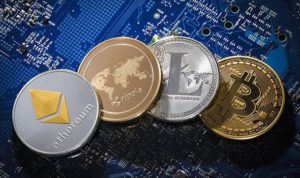
A US business (of any size) wants to raise some capital. It does so using “Reg S”, which permits it to raise money from non-US investors with very few restrictions. Money flows into the company from offshore investors, which is a good thing as the business gets funded and jobs get created.
The company doesn’t have to worry about whether those investors are “accredited” or not. The company doesn’t have to make any regulatory filings. And those offshore investors can list their “stocks” or “bonds” (in the form of tokens) on a non-US exchange and start trading them immediately.
Those non-US exchanges can even publish investor research reports on the tokens they trade! A US person wants to buy a house or a car. They do so by getting a loan from an offshore lending platform (which holds title to the home or auto with a US trust company).
The offshore lender then tokenizes that real estate (or automobile) loan and sells it on non-US exchanges. And if that’s murky due to US lending regulations? Okay fine, then the offshore lender might perhaps buy the home and enter into a contract where the homeowner rents it and buys it little by little (similar to the model used by Islamic banks).
Result is the same, the profits are made by investors globally…everywhere except the US. The rise of infrastructure businesses. Much ado has been made about custodians, and rightly so. Assets need to be held by a regulated trustee.
There is a huge need for fiat on-and-offramps. And many investors will want their tokens held on statement just like they do their stocks, bonds and mutual funds. But besides trust companies and banks, there are other unicorns in the making…Tokenization of assets requires help with creating smart contracts, and with managing them.
It requires innovative blockchains that provide faster settlement of transactions, good KYC/AML, and tools to handle/reverse criminal acts. It requires front-end servicers to originate a flow of funds by connecting people who need funds with people who have money.
It requires settlement mechanisms. It requires secondary trading exchanges, intermediaries and research. It requires debt (and fractionalized ownership) servicing firms. It requires a new breed of legal and accounting representation. And it requires new types of businesses to handle/create/manage things which we cannot yet imagine.
Many of these businesses are already in play. Some are pivoting their well-established business models to address this market, including StartEngine, Republic, Overstock, Cohen & Co, PwC, and of course Prime Trust.
Others are new firms that have been purpose-built for this new era, including HBUS, TrustToken, tZero, OKEX, KOI, CoinList, Polymath, Harbor, TokenSoft, OTCXN, AlphaPoint, Daollar, BHEX, Bitrue, Carbon, Stably, AnchorCoin, Stronghold, Consensys, and countless others across all types of service providers. 2019 is going to be exciting.
I think it’s when the rubber truly starts to meet the road, following the shakeout of the vaporware that accumulated in prior years, which I chalk up as proof-of-concept for blockchain. I can’t wait for the new year.
-
Francisco Gimeno - BC Analyst Quite common sense predictions here. We are witnessing a new world happening, with more and more active roads, a second Wild West opening of opportunities, with all the good and bad, pioneers, scammers and, in the centre, the idea that this is going to change everything for those now participating and in the next future for anyone willing to participate. What about you?
-
-
Report: State of the Digital Assets Industry
Bitcoin: Volatility Downtrends, Commerce Audience Still at Large
Decentralized Applications Face Half-Life After PeakCoinbase Vies for Binance, Huobi Traders with Paradex ListingsUser Experience Addendum
Letter from the Publisher
Bitcoin’s rise to fame was certainly not the result of media focus and speculation gains witnessed for the better part of 2017 alone. It was the result of the devotion of a very zealous community who developed, shared and promoted a concept nobody had fathomed – a currency aimed for the masses, with no intervening power.
The 2008 Financial Crisis that motivated Satoshi Nakamoto to develop such a cryptocurrency wasn't the worst the world has seen since. Citizens in Venezuela, Iran and Turkey burden a massive devaluation to their national currency.
World debt continues to climb unabated. And with no end in sight for Quantitative Easing policies in Europe – and despite recent Federal Reserve tightening, economists are fearing the overheating of the US economy. The cherry on top, two powerhouse economies, the US and China, have seen both sides amp up rhetoric resulting in glimpses of a trade war.
In Cyprus, systemic bank failures led to the seizure dubbed "Bail-in" of customer deposits in the Billions of Euros - with no responsibility or remorse. And Capital Controls in Greece following painful austerity measures invoked by the European Central Bank, the International Monetary Fund and the European Commission left people stranded at ATMs across the country to pull out their allotted allowance of 60 Euros a day.
Both events this editor lived through first hand.Bitcoin's value does not solely come from its monetary policy. The real ownership of an asset class that is spendable in a digital era are remarkable traits.
And Central Banks have taken serious note of technological and societal developments. They are now faced with digital currency design decisions as Stablecoins are set to enter the market. The prospect of both cannot be understated.
Central Bank Digital Currency has the opportunity to provide social good should the design be geared towards retail as opposed to wholesale. Otherwise, Stablecoins could pose challenges should developers create a user-friendly experience that can also attract commerce in the face of behemoths such as Visa and Mastercard.
|| TIME TO LOOK AT THE WHOLE PICTURE
While this vibrant cryptocurrency community has drawn people in with great fervor, so has it repelled intelligence of contrary opinion. There comes a time to discuss progress with reason and debate without the risk of being ostracized and labeled peddler spreading fear, uncertainty, and doubt.
The "either you're with us or against us" has proved a false mantra time and time again.The data are in - it's not flattering for Bitcoin as a trade unit. Decentralized Apps have also failed to find a loyal crowd.
Efforts on this front would only turn pear shaped should the community fail to examine the current status of the whole currency and financial ecosystem with critical consideration.
Continue reading the full free report from Diar here... https://diar.co/volume-2-issue-33-34/
--
Fadi Aboualfa
Publisher & Editor-in-Chief-
By
 Admin
Admin - 2 comments
- 2 likes
- Like
- Share
-
Francisco Gimeno - BC Analyst Being a blockchain and crypto believer doesn't mean we have to throw common sense through the window. We should be on the agora discussing, debating, defending blockchain as a powerful and disruptive tool, and crypto as the foundation for the new economy, without closing eyes to the problems and issues arising (speculation, lack of use cases, no crypto mass adoption yet, scalability, etc etc). Being only among the like minded is very nice but produce fantasies.
-
By
-
Tim Enneking, Robert Brauer & Andrew Kang
Tim Enneking is managing director at Crypto Asset Management. Robert Brauer and Andrew Kang are members of the Crypto Asset Management ICO Analysis team. The number of initial coin offerings (ICOs) is growing rapidly, having raised an astounding $5.6 billion in 2017 alone.
More outrageous is that, by most estimates, over half of the ICOs launched in 2017 have already failed.In addition to the hundreds of ICOs being launched every month, our management company Crypto Asset Management (CAM), also receives around a dozen emails per day from new companies planning on launching crypto tokens to raise capital.
CAM, through the various funds and share classes it manages, invests in less than one out of every 100 ICOs that comes across its desk.Out of absolute necessity, we have developed an analytical framework for ICOs, which CAM applies to every such opportunity it evaluates.
In this article we explain what we call The Seven Pillars Of ICO Investing™, which we've rigorously crafted over several years of investing in crypto and other assets.Pillar #1: Team
The critical element which we are searching for is an experienced team, ideally with a strong track record in developing and launching blockchain technology. In addition, the team should have experience in the market it is targeting. A team that is not only competent, but capable of developing, completing and/or expanding the project is paramount to its success.A couple of additional issues to consider are:- Does the team have a vesting token schedule that will properly incentivize it?
- Do the advisors have the right experience and are they actively engaged?
- Does the project have any notable financial backers? (VCs, other hedge funds, etc.)
Pillar #2: Idea
Without a compelling, realistic and timely idea for a blockchain-based enterprise, the investment will almost certainly fail.A few of the key things we look for are:- Total addressable market: How large is the opportunity? We want as large of a market as possible (See: ethereum, filecoin).
- Product-market fit: Does the business address an urgent problem? (0x, ChainLink)
- Unique value proposition: What facets of the technology enable it to stand out from the competition? How much competition is there (Wax)? Ideally, the token has proprietary technology, and as little competition as possible (Orchid Protocol).
There is clearly an interrelationship between Pillars 1 and 2. However, if we had to choose between them, we would clearly rather invest in an "A" team working on a "B" idea than a "B" team working on an "A" idea.A talented group of people are the lifeblood of any business, and crypto is no different.Pillar #3: Execution
In the cut-throat business world we live in, the only thing that matters is results. A brilliant idea and great team are nice, but execution is everything. Is there a working prototype or does your idea only exist in a nebulously written white paper?
We prefer to invest in a product that already exists to some degree (Presearch, Basic Attention Token, Superbloom, FunFair), whether in the crypto space or analogously in the fiat space (Wax). Finally, we look for some sort of proof that the company will be able to hit future milestones.Pillar #4: Legal/Regulatory
This pillar is essential given the current and growing regulatory uncertainty in the industry. Almost every week, there is news of a governmental agency in one country or another taking regulatory action or making a new statement around ICO governance. Of course, almost as often, there is news of a different country considering crypto-favorable legislation.
Comprehensive regulation in many marketplaces is on the horizon and it is imperative to ensure that ICOs vigilantly navigate the landscape to the best of their abilities. The threshold issue is jurisdiction: in what country is or will the ICO company be incorporated and the ICO executed?
This determines the rules that will apply to the company's actions and the ICO. Depending on the approach taken, we may apply the somewhat arcane rules of the Howey test (in the US or if US investors are targeted or allowed to invest), KYC/AML principles (which are essentially universal) and applicable securities law.Pillar #5: Tokenization
A significant number of the ICOs we analyze do not actually need the blockchain, tokenization or a public sale of their tokens to be successful. When this is an issue, it is usually the last - public sale - which is not necessary. (NASDAQ's settlement system is an excellent example of where tokenization is a brilliant idea but a public market would be superfluous, or even counterproductive.)
Also, they are sometimes glorified apps that could be built without creating a specific token, despite how much "utility" the founders may claim their token provides. With the enormous amount of value exchanging hands over the blockchain and the prospect of getting "free" money without giving up any equity, it's not hard to imagine why many industrious entrepreneurs try to identify any possible reason to launch an ICO.
That being said, one of the crucial things that every investment we make must have is a legitimate reason for "tokenizing" their business, and for creating a public market for that token (OmiseGo, Icon, Raiden Network, Cosmos).Pillar #6: ICO Structure
Similar to traditional venture capital investing, the financial underpinnings of the deal ultimately determine the decision to invest. The characteristics of an ICO can have important implications on the expected upside of the token.This can be split out into two categories - ICO mechanics and ICO deal structure.- ICO Mechanics - Historically, ICOs with a lower hard cap tend to outperform ICOs with massive hard caps. While it is important that the parent companies be well funded and have sufficient runway to work with, ICOs need to have a convincing plan for use of proceeds as the potential upside decreases in proportion to the amount raised. The precise metric here is valuation of the token economy - a derivation of the hard cap. Both the valuation in light of circulating tokens at launch and the valuation upon release of all tokens are factors that we consider.
- ICO Deal Structure - The deal should be structured in a way so that investors are not at a disadvantageous position to the market.These are a few of our considerations:
- Distribution: The team should have a compelling structure for the distribution of tokens, fair allocation among team/advisors and investors, programs for market uptake, etc.
- Distribution Schedule: Given the fast-moving pace of the crypto market, the distribution schedule should not massively favor specific parties. While long distribution periods can be considered acceptable for high-potential ICOs, individual liquidity preferences should be considered.
- Discounts: Discounts are ubiquitous in the ICO environment, so examining the discount levels given to different tranches allows investors to understand where they stand in relation to other stakeholders.
- Equity Stakes: At Crypto Asset Management, we like to be part of the growth of the company and investing directly into the equity of a company allows us to play a greater role in that development. In the world of token sales and short-term liquidity, people often forget that the value proposition of a company can be just as great or even greater than the token ecosystem it is developing.
Pillar #7: Price Drivers
Even if we believe a team is able to create a great product that incorporates a token with an imperative use case, this does not necessarily mean that we will want to hold the token or invest in the ICO. A token must additionally have a mechanism to drive price appreciation.
A token with constant supply without any incentive to hold, will not be subject to buying pressure which significantly outweighs selling pressure over the long run (Votes).
This is underpinned by the concept of price risk, in which individuals will lean towards reducing their exposure to price volatility in favor of fiat or a form of stable currency. (Kyle Samani has written an in-depth piece on this velocity problem here.)A few of the price drivers we look for include:- Network Volume: In almost every instance the value of a token increases as the number of transactions on the blockchain increases (bitcoin, ethereum). This is one of the most basic, yet influential, indicators of demand, and is also the reason we invest primarily in protocols rather than dapps.
- Market Leadership: We look to invest only in tokens that are clear market leaders, or have the potential to be in the near future. Usually, these tokens have a distinct and growing unique advantage over their competition (Practical VR).
- Incentives to Hold: There is a clear reason why a user would rather hold than spend the token, which can be related specifically to speculated price increases or other non-monetary rewards (Presearch, PROPS). We won't invest in a token that's only purpose is a medium of exchange.
- Supply Changes: This can include limiting inflation, meaning the token supply does not dilute the value of all tokens over time, or token burning, where the supply of tokens in the system decreases over time (Binance Coin, Iconomi).
- Profit Sharing: Part of the value that is extracted from the system is given back to the token holders (Augur, NEO, Neon Exchange, Ethorse).
- Staking: Having users of a network to lock up their tokens either for network consensus or as a requirement in certain processes. (Bee Network, Open Platform, NuCypher, Video Coin).
- Sufficient Liquidity: If the project isn't proactive about getting listed on multiple exchanges, preferably top-tier exchanges, we will likely not make an investment.
Please note that, as a general rule, we are not in favor of asset-backed tokens as an investment vehicle at this time. There are no real drivers of price formation after an initial, relatively small boost for convenience (Sandcoin, OneGram) and the opportunity cost is consequently too high (there are far greater returns elsewhere).Importantly, the effect of implementing strong incentives to hold is multiplicative.
Not only will the price increase be driven by the inherent tokenomics design, but also by speculation directly related to the implementation of these drivers. Despite the incredible number of fly-by-night operations in the world of ICOs, it is certain that token generation events are here to stay.
Such events are completely transforming the traditional venture capital industry and, for savvy investors, are creating fortunes literally overnight. For unsophisticated or undisciplined investors, ICOs are a minefield that should probably be avoided.
However, for those who perform proper due diligence, the odds increase for realizing breathtaking returns on your investments.This article is an abbreviated summary of our process for investing in ICOs.
Here at Crypto Asset Management, we've also developed more in-depth tools, such as our innovative 64-point ICO Scorecard and a more traditional Private Equity Due Diligence Checklist.
Stack of coins via Shutterstock
The leader in blockchain news, CoinDesk is a media outlet that strives for the highest journalistic standards and abides by a strict set of editorial policies. CoinDesk is an independent operating subsidiary of Digital Currency Group, which invests in cryptocurrencies and blockchain startups.
Discover more insights from Coindesk here: https://www.coindesk.com/seven-pillars-ico-investing/-
By
 Admin
Admin - 0 comments
- 2 likes
- Like
- Share
-
The written testimony from Jay Clayton, chairman of the United States Securities and Exchange Commission (SEC), was released on February 5, 2018. It comes ahead of the chairman’s oral testimony before the U.S. Senate Committee on Banking, Housing and Urban Affairs on February 6, 2018, on the matter of “Virtual Currencies:
The Oversight Role of the U.S. Securities and Exchange Commission and the U.S. Commodity Futures Trading Commission.”Usually the written testimony closely mirrors the language we can expect in the oral testimony today.
Going through the written testimony, there are several key takeaways to note. (If the opinions of the chairs contained in this article seem familiar, it’s because they co-authored an op-ed in the Wall Street Journal on January 24, 2018, ostensibly laying the groundwork ahead of their testimony.)
Point #1: IF you seek to raise capital to fund an enterprise via an ICO, the SEC views this as the offer and sale of securities, and your venture is subject to the laws governing the sale of securities.For those in the cryptocurrency world, this is bad news if the coin you are invested in is determined to be an actual security. On page 3 of his written testimony, Clayton stated:There should be no misunderstanding about the law. When investors are offered and sold securities — which to date ICOs have largely been — they are entitled to the benefits of state and federal securities laws and sellers and other market participants must follow these laws.
It seems Chairman Clayton believes most ICOs are unregistered securities; meaning, if they are to be considered as such, they’d be in violation of state and federal laws. Clayton further evidences this supposition, noting, “For those who seek to raise capital to fund an enterprise, as many in the ICO space have sought to do, a primary entry into the SEC’s jurisdiction is the offer and sale of securities, as set forth in the Securities Act of 1933.
” Here, Clayton is stating that ventures seeking to raise funds via an ICO should consider, as a “primary entry,” registering as a security with the SEC.At the crux of the chairman’s points here is an argument the industry has faced in a fundamental fashion, especially on ICOs.
That argument is, as Clayton puts it on page 6 of his testimony, “Is the coin or token a security?” While Clayton does demur to say that the answer to his ICO question depends on the individual facts of each coin or token, he does state that “to date no ICOs have been registered with the SEC, and the SEC also has not approved for listing and trading any exchange-traded products (such as ETFs) holding cryptocurrencies or other assets related to cryptocurrencies.”
How Clayton Arrives at That Point:As a governing definition of securities, Chairman Clayton cited §2(a)(1) of the Securities Act of 1933 as well as §3(a)(10) of the Securities Exchange Act of 1934. (These two Acts are two of the primary three bodies of law that outline most of the regulations of the U.S. investment industry — the third being the Investment Advisers Act of 1940, or the “40 Act” colloquially.)
These sections define a security as “includ[ing], among other items, ‘an investment contract.’” According to federal laws under Title 15 of the U.S. Code, an investment contract is “an investment of money in a common enterprise with a reasonable expectation of profits to be derived from the entrepreneurial or managerial efforts of others.” See 15 U.S.C. §§ 77b–77c.
Point #2: The U.S. regulators will apply the same “facts and circumstances” analysis, utilizing a principles-based framework to determine if ICOs and cryptocurrency markets should be classified as securities.
This is a potential sigh of relief for the cryptocurrency industry. If the chairs remain steadfast on this point, it appears that any crackdown on different coins will come in piecemeal fashion and on the merits of the coins individually, rather than from a broad-swept ruling.
Referring in his testimony to a report issued on July 25, 2017, on DAO tokens as a test case, the chair seems to suggest the methodology for determining that DAO tokens are securities should be allegorized to other coins or tokens offered in the space.
Going further on page 7 of his testimony, the chair states that “the Commission’s message to issuers [those who conduct the ICO] and market professionals in the space was clear: those who would use distributed ledger technology to raise capital or engage in securities transactions must take appropriate steps to ensure compliance with federal securities laws.
”Point #3: We are doing this in the name of “Investor Protection.”This is the preemptive Fear, Uncertainty and Doubt (FUD) propagating line that is being towed about by every regulator safeguarding an economy more prosperous than North Korea’s.
However, the point that Chairman Clayton makes on cryptocurrencies is not without merit.Specific types of investor protection that the new application of the current regulatory framework to cryptocurrencies hopes to improve on include:- improper or nonexistent disclosure (KYC/AML);
- volatility (flash-crash-like issues, endemic asset class issues that could cause a marketwide panic among all investable asset classes); and
- all of the theft and fraud in the industry.
As the chair puts it in the portion of his written testimony entitled “Enforcement,” there has been a new cyber unit established within the SEC’s Enforcement Division in September of 2017, focused on misconduct involving the industry specifically targeting those types of behaviors listed above.
Point #4: Cryptocurrencies aren’t “currency,” but some of them aren’t “securities” either.The chairman doesn’t come out right and directly say this, but on page 5 of his written testimony, he states:While there are cryptocurrencies that, at least as currently designed, promoted and used, do not appear to be securities, simply calling something a ‘currency’ or a currency-based product does not mean that it is not a security.
The chair does note slightly above in his testimony that “the SEC does not have direct oversight of transactions in currencies or commodities, including currency trading platforms.
”Point #5: But save some prohibition for the average individual investor...Prohibiting certain classes of investors from participating in a security or marketplace is nothing new.
For example, certain private offerings are only allowed to accredited individual investors, while others are reserved for the more specific classes of investor.As individual investors in the cryptocurrency space (“Retail Investors” or “Main Street Investors”), the following statements in the written testimony are disheartening.
SEC Chair Clayton states on page 2 of his written testimony that his efforts “have been driven by various factors, but most significantly by the concern that too many Main Street investors do not understand all the material facts and risks involved.
” While it’s no surprise to investors that cryptocurrencies are currently a volatile and risky asset class, even the hint that Main Street investors lack the understanding of this notion often serves as rationale for restricting non-accredited retail investors from access to more complicated or illiquid financial instruments.
The chair then further stated, “Many trading platforms are even referred to as ‘exchanges.’ I am concerned that this appearance is deceiving.” In Clayton’s view, investors transacting on these exchanges do not receive many of the market protections that they would in traditional investment exchanges.
While the chairman could be lauded for his sentiment on protecting investors, especially given that the risks of trading on exchanges have exposed investors to loss in the past, the alternative view of his statement is that the SEC chairman is seeking to find a way to regulate the exchanges that provide Retail Investors access — leaving cryptocurrencies legally accessible only to those sufficiently educated on the risks, the product and the space or, as in the case of accredited investors, allowing only the rich to invest in cryptocurrencies.
We will have an update on takeaways from the Senate Hearing shortly.
This Report is published by BitconMagazine.com. To discover more insights in cryptocurrencies and blockchain, visit us here: https://bitcoinmagazine.com/articles/sec-chairs-written-testimony-hints-moderation-cryptocurrencies-...
Help friends or someone you care about discover blockchain and
cryptocurrencies, by simply sharing this page. Don't keep it to
yourself.....share Blockchain Company (BC).
Did You Know About This?
You can curate a Personal Blockchain Page right here on Blockchain Company ( BC ) like these 2 great user examples here:
http://www.blockchaincompany.info/Paula
http://www.blockchaincompany.info/Francisco
Show
your blockchain page off to your employer, colleagues and friends. It
demonstrates your professional awareness and competency of this
revolutionary paradigm changing the world. It's free if you are a
consumer user. Just Create your Account here in less than 3 mins!
Or
Click Create Account above in the upper right corner. Instructions how
to curate your blockchain page from information you discover on BC, is
sent in your email after you sign up.
You might be able to capture your ' first name " unique url for your blockchain page too! Like : http://www.blockchaincompany.info/robert
You
may be entitled to cryptocurrency tokens, offers and discounts at any
time in the future once you are a user on our platform.
-
By
 Admin
Admin - 0 comments
- 2 likes
- Like
- Share
- improper or nonexistent disclosure (KYC/AML);
-
If you were lucky enough to buy Bitcoin early on, the chances are that you are retired now. No other investment in the world has performed like BTC over the last few years and those that saw the revolution coming are now multi-millionaires.
This success has led to an influx of investors trying to find the next big cryptocurrency so that they can make thousands of percent returns in only a few years. In this article, I will give you the best tips to help you to find the next Bitcoin.
Finding the next big cryptocurrency can take up a lot of time as hundreds of new coins are coming to the market each month. Not all of these will be successful so it is vital that you do not go all in or you could end up losing everything.
There are still many risks involved with cryptocurrencies such as regulation which over 2018 will be the hot topic and if the regulations go the wrong way for the currency that you have bought, it could be worthless. Below are my top tips for finding the best new cryptocurrencies of 2018:#1: PRICE
If you are looking to make big bucks by buying cryptocurrency one of the best ways to do this is by looking for new ones that are priced at below a dollar. This is a great tactic for investors that do not have great deals of money to invest. If you do use this tactic it is important to spread your risk by investing in a number of cryptos and not just one.
Due to the fact that you are buying so cheaply, it is possible that a number of these may treble or more in the value over a short space of time. A prime example of this is the likes of RubleBit that increased 522% over 7 days along with Cyder which saw an increase of 7,412%.#2 CURRENCY ADAPTATION
When carrying out research you will need to ascertain which coins will be the most adopted. You want to choose ones that have the best chance of being adopted as a currency. By doing this you can make estimates of the intrinsic value once the coin reaches mainstream adoption or a set level.#3: BUZZ AND FOLLOWING
One of the biggest driving factors of new cryptocurrencies is the amount of buzz it creates. One of the best places to find out this is by visiting the Bitcoin Reddit group or one of the many other cryptocurrency social media groups. See which ones everyone is talking about and use it to help guide you to the ones you should investigate further before buying.#4: HIGHLY CIRCULATED SUPPLY
One factor you need to pay close attention to is the maximum supply level. You want to try instead to go for coins that are highly circulated supply as they have a better chance to go up in price if demand increases due to a limited supply.#5: PRICE AND VOLUME CHARTS
One of the best sources of information to check before buying a cryptocurrency is the price and volume charts. Look for ones with accelerating growth for both price and volume to find one that has momentum behind them.CONCLUSION
If you are investing in cryptocurrency or ICOs is it a high-risk investment. If you get it right along with the right regulation falling into place, you could set your family up for life. It is extremely hard to make predictions because there are so many fast-moving parts which are why spreading risks is the best investment strategy.What do you think of the author’s tips?
What other advice would you include? Let us know in the comments below.
Bitcoinist does not endorse and is not responsible for or liable for any content, accuracy, quality, advertising, products or other materials on this page. Readers should do their own research before taking any actions related to the company.
Did You Know About This?
You can curate a Personal Blockchain Page right here on Blockchain Company ( BC ) like these 2 great user examples here:
http://www.blockchaincompany.info/Paula
http://www.blockchaincompany.info/Francisco
Show your blockchain page of to your employer, colleagues and friends. It demonstrates your professional awareness and competency of this revolutionary paradigm changing the world. It's free if you are a consumer user. Just Create your Account here in less than 3 mins!
Or Click Create Account above in the upper right corner. Instructions how to curate your blockchain page from information you discover on BC, is sent in your email after you sign up.
You might be able to capture your ' first name " unique url for your blockchain page too! Like : http://www.blockchaincompany.info/robert
You may be entitled to cryptocurrency tokens, offers and discounts at any time in the future once you are a user on our platform.
-
By
 Admin
Admin - 0 comments
- 2 likes
- Like
- Share
-
By
-
Lie #1: The ‘Black and White’ FallacyIn the previous article, I pointed out that Bitcoin wasn’t sufficiently similar to other things to draw comparisons. A common response: I fell into my own trap by making comparisons between, say, the Bitcoin bubble and other speculative bubbles or between Bitcoin and ‘real’ money.
Such responses are examples of the black and white fallacy: assuming that for a given argument, only the two most extreme positions are under consideration. Such extremist thinking pervades the cryptocurrency world.
A common argument that succumbs to this fallacy: there are problems with putting governments in charge of the money supply, so we need a money supply independent of any government. Perhaps working within the system to improve how government operates would be more efficacious, hmm?
Lie #2: Bitcoin’s Market Cap is RelevantThe formula for market capitalization is simple, but deceiving: multiply the number of Bitcoin (or any altcoin) in existence by the market value of such a coin, and voila! A number that represents…what, exactly?
As I write this, Bitcoin’s market cap is over a quarter of a trillion dollars. That doesn’t mean, however, that there’s a bucket with that much cash in it under a rainbow somewhere, ready to be divvied up amongst all the lucky leprechaun-seekers holding Bitcoin.
In reality, when the bubble is about to pop and everyone seeks to cash in, the total amount to be divvied up can never be more than the amount people invested in Bitcoin over time – and that number is far, far smaller than its current market cap.
Lie #3: Decentralized Transaction Processing is a Good IdeaAs with any blockchain-based technology, every cryptocurrency’s transaction infrastructure depends upon a number of decentralized transaction processors.In the case of Bitcoin, we call these processors ‘miners,’ because of the Bitcoin infrastructure rewards such miners with new Bitcoin.
For cryptocurrencies that follow this model (and not all of them do), there are a number of problems. Mining becomes increasingly expensive and consumes massive quantities of electricity – but those aren’t even the biggest problems.
The ticking time bomb behind Bitcoin and all similar currencies: if the market value of the reward for mining drops below the cost of mining, then miners will stop mining.
Which means that nobody will process transactions. Which means the entire Bitcoin infrastructure grinds to a halt. For good.For altcoins that don’t reward transaction processors with new coins, there’s even less reason to continue to participate once the hype dies down.
The solution? Centralize transaction processing, like Visa V +0.4%, Mastercard MA +0.3%, and all the banks do. Which, of course, makes cryptocurrency pointless.
Lie #4: ‘HODL’ is a Rational StrategySome cryptocurrency speculators are all too happy to sell on the upswings and buy on the downswings, a surefire way to make money – as long as you can time your transactions properly, of course.
But other speculators are HODLers – HODL standing for ‘hold on for dear life.’ The HODL strategy assumes that the value of Bitcoin or altcoin in question will multiply many times in the future, and thus a HODLer won’t sell no matter how volatile the price.In reality, the sheer quantity of HODLers are simply propping up the speculative value of the cryptocurrency, giving the more active traders a better chance of getting out with some profit.
Remember, the only people who make money in a speculative bubble are the ones that get out in time. Everyone else is a loser. Which is essentially what HODLers are.
Lie #5: Cryptocurrencies Can Be a Viable Medium of Exchange and also Artificially ScarceBitcoin’s most important innovation is perhaps its artificial scarcity.
There is a maximum number of possible Bitcoin, creating more is increasingly difficult, and the blockchain infrastructure prevents double-spending any of it. Such artificial scarcity is essential to Bitcoin’s speculative value, but operates at cross purposes with any effort to make it a viable medium of exchange.
After all, who would want to buy – or sell – a cup of coffee with Bitcoin if one day that cup cost $5, the next $50, and the day after that $10?In fact, if I were to invent a cryptocurrency that could serve as a viable medium of exchange, it would make far more sense to base the value of one of my coins on, say, an average of the top ten fiat currencies (aka ‘real money’).
Such a cryptocurrency wouldn’t have artificial scarcity, however, and thus wouldn’t be particularly useful as a speculative vehicle. And where’s the fun in that?
Lie #6: Innovation in Altcoins Will Fix the Issues with BitcoinThere are hundreds of altcoins out there, with more appearing out of nowhere every day.
Now that even die-hard Bitcoin aficionados are realizing that Bitcoin itself has a number of technical issues, they are rapidly jumping ship to various altcoins that purport to solve the problems with Bitcoin. The problem with this argument is that by far the primary motivation for this shift are Bitcoin’s shortcomings as a medium for criminal enterprise. It’s not anonymous enough for child pornographers and too volatile for money launderers, in particular.
So where is the innovation focusing? On altcoins that better meet the needs of such criminals – not on priorities that align with bona fide, legal business drivers. From the perspective of legal commerce, today’s innovation is creating more issues, not fewer.
Lie #7: Coins from ICOs will Have ValuePerhaps the craziest corner of an already insane cryptocurrency circus is the world of initial coin offerings (ICOs). Vaguely similar to initial public offerings (IPOs), ICOs are a way for startups to raise money from investors.
That, however, is where the similarities end. In essence, to implement an ICO, a startup creates a large number of some brand-new kind of altcoin out of thin air and sells many of them to speculators. There are a number of variations on the specifics, including how many of the altcoins the founders retain and what can be done with extra ones left over after the ICO.
The startup then supposedly uses the real money they get from selling the fake Monopoly money they just printed up to get a blockchain-related business off the ground (unless they’re complete scammers, of course, which many are).
Then something magical happens, and everyone who bought the altcoins at the ICO sells them for a profit. Just what magical occurrence imbues such worthless bits of, well, bits, depends upon the business model of the startup – but one thing the investors don’t get is an ownership stake in the company.
At least you can play Monopoly with real Monopoly money. However, with ICO-generated coinage, there is rarely even a speculative market, because there are simply too many ICOs with too many new altcoins.Want to put a hotel on Park Place? You’re out of luck.
All that new altcoin isn’t worth the paper it’s printed on – if there were paper, which there isn’t.Welcome to the world of cryptocurrency.Intellyx publishes the Agile Digital Transformation Roadmap poster, advises companies on their digital transformation initiatives, and helps vendors communicate their agility stories.
As of the time of writing, none of the organizations mentioned in this article are Intellyx customers. Image credit: Alan Levine.
Jason Bloomberg is president of industry analyst firm Intellyx. Follow Jason Bloomberg on Twitter or LinkedIn.
Forbes is a daily publisher of Blockchain, Cyptocurrencies, Business and Financial Markets. Discover a lot more from Forbes here: https://www.forbes.com/sites/jasonbloomberg/2018/01/07/seven-more-lies-bitcoin-and-altcoin-fans-tell...
Did You Know About This?
You can curate a Personal Blockchain Page right here on Blockchain Company ( BC ) like these 2 great user examples here:
http://www.blockchaincompany.info/Paula
http://www.blockchaincompany.info/Francisco
Show your blockchain page of to your employer, colleagues and friends. It demonstrates your professional awareness and competency of this revolutionary paradigm changing the world. It's free if you are a consumer user. Just Create your Account here in less than 3 mins!
Or Click Create Account above in the upper right corner. Instructions how to curate your blockchain page from information you discover on BC, is sent in your email after you sign up.
You might be able to capture your ' first name " unique url for your blockchain page too! Like : http://www.blockchaincompany.info/robert
You may be entitled to cryptocurrency tokens, offers and discounts at any time in the future once you are a user on our platform.
-
By
 Admin
Admin - 0 comments
- 2 likes
- Like
- Share
-
By
-
Unless you’ve been hiding under a rock, I’m sure you’ve heard of Bitcoin and blockchain. After all, they are one of the most trending topics these days — the ultimate buzzwords of the year.
Even people who’ve never mined cryptocurrency or understand how it works, are talking about it.My non-techie friends are completely at loss when it comes to understanding these new technologies, and have been bugging me for weeks to explain it to them. There must be thousands of other regular internet users out there who feel the same.
As a super early miner of Bitcoin, I’ve taken it upon myself to write this post in the plainest English so that anyone can understand today’s most trending technology.Blockchain: Why do we even need something this complex?
“For every complex problem there is an answer that is clear, simple, and wrong.” — H. L. Mencken
Unlike most posts on Bitcoin and blockchain, which usually begin right away with trying to define blockchain, I want to explain first the problem it solves.Imagine Joe is your best friend. He’s traveling overseas and on the fifth day of his vacation he calls you and says:
“Dude, I need some money. I’ve completely run out. ”You, being the nice person you are, reply “sending some right away,” and hang up.
You then call your account manager at your bank and tell him, “Please transfer $1000 from my account to Joe’s account.”Your account manager replies, “Yes, sir.”He opens up the register, checks your account balance to see if you have enough balance to transfer $1000 to Joe. Because you’re a rich person you have plenty to spare; thus, he makes an entry in the register like the following: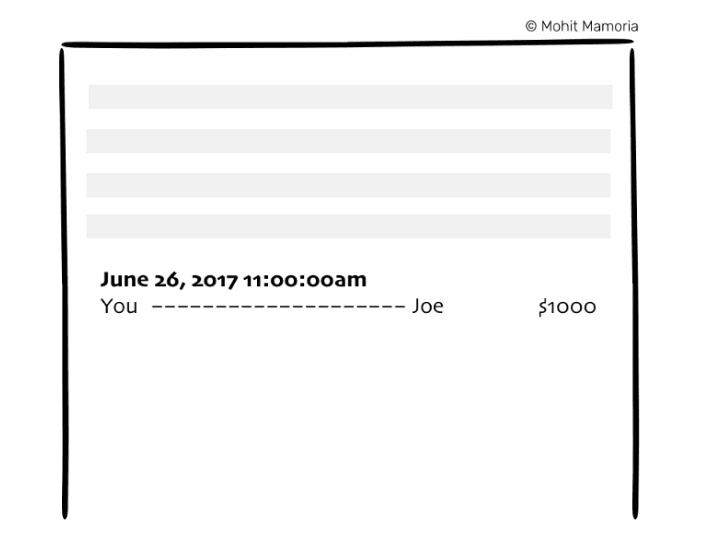
The Transaction RegisterNote: We’re not talking about computers only to keep things simple.You call Joe and tell him, “I’ve transferred the money. Next time you go to the bank you can withdraw the $1000 that I have just transferred.”
What just happened? You and Joe both trusted the bank to manage your money. There was no real movement of physical bills to transfer the money. All that was needed was an entry in the register. Or more precisely, an entry in the register that neither you nor Joe controls or owns.And that is the problem of the current systems.To establish trust between ourselves, we depend on individual third-parties.
For years, we’ve depended on these middlemen to trust each other. You might ask, “what is the problem depending on them?”The problem is that they are singular in number. If chaos has to be injected in the society, all it requires is one person/organization to go corrupt, intentionally or unintentionally:- What if that register in which the transaction was logged gets burnt in a fire?
- What if, by mistake, your account manager had written $1500 instead of $1000?
- What if he did that on purpose?
Could there be a system where we can still transfer money without needing the bank?To answer this question, we’ll need to drill down further and ask ourselves a better question (after all, only better questions lead to better answers).Think about it for a second, what does transferring money means? Just an entry in the register. The better question would then be
For years, we have been putting all our eggs in one basket – someone else’s.Is there a way to maintain the register among ourselves instead of someone else doing it for us?
Now, that is a question worth exploring. And the answer is what you might have already guessed. The blockchain is the answer.It is a method to maintain that register among ourselves instead of depending on someone else to do it for us.Are you still with me? Good. Because now, when several questions have started popping in your mind, we will learn how this distributed register works.So, how does it work?
The requirement of this method is that there must be enough people who would like not to depend on a third-party. Only then this group can maintain the register on their own.“It might make sense just to get some Bitcoin in case it catches on. If enough people think the same way, that becomes a self-fulfilling prophecy.” — Satoshi Nakamoto in 2009
How many are enough? At least three. But for our example, we will assume ten individuals want to give up on banks or any other third-party that manages transactions. Upon mutual agreement, they have details of each other’s accounts all the time — without knowing the other’s identity.
1. An Empty Folder
Everyone contains an empty folder with themselves to start with. As we’ll progress, all these ten individuals will keep adding pages to their currently empty folders. And this collection of pages will form the register that tracks the transactions.2. When A Transaction Happens
Next, everyone in the network sits with a blank page and a pen in their hands. Everyone is ready to write any transaction that occurs within the system.Now, if #2 wants to send $10 to #9.To make the transaction, #2 shouts and tells everyone, “I want to transfer $10 to #9. So, everyone, please make a note of it on your pages.”
Everyone checks whether #2 has enough balance to transfer $10 to #9. If she has enough balance, everyone then makes a note of the transaction on their blank pages.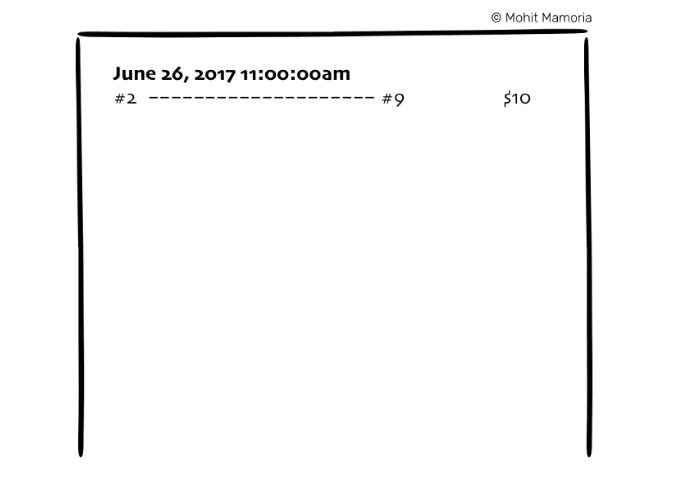
First transaction on the pageThe transaction is then considered to be complete.3. Transactions Continue Happening
As the time passes, more people in the network feel the need to transfer money to others. Whenever they want to make a transaction, they announce it to everyone else. As soon as a person listens to the announcement, (s)he writes it on his/her page.This exercise continues until everyone runs out of space on the current page. Assuming a page has space to record ten transactions, as soon as the tenth transaction is made, everybody runs out of the space.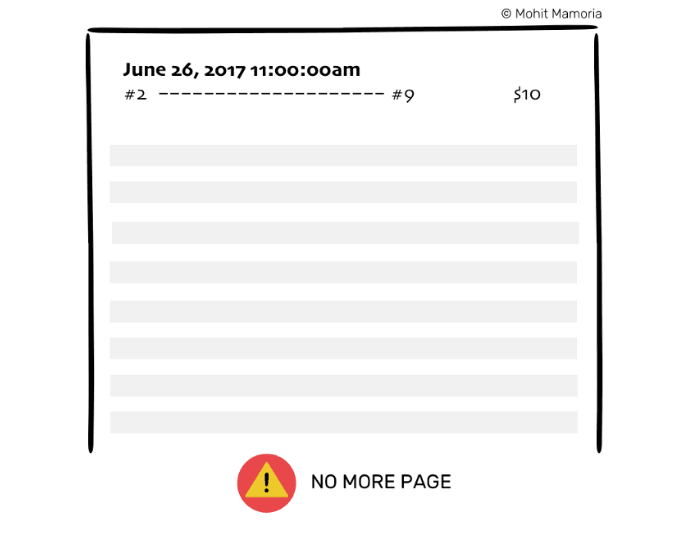
When page gets filledIt’s time to put the page away in the folder and bring out a new page and repeat the process from the step 2 above.4. Putting Away The Page
Before we put away the page in our folders, we need to seal it with a unique key that everyone in the network agrees upon. By sealing it, we will make sure that no one can make any changes to it once its copies have been put away in everyone’s folder — not today, not tomorrow and not even after a year. Once in the folder, it will always stay in the folder — sealed. Moreover, if everyone trusts the seal, everyone trusts the contents of the page. And this sealing of the page is the crux of this method.[Jargon Box] It is called ‘mining’ on the page to secure it, but for the simplicity of it, we’ll keep calling it ‘sealing.’
Earlier the third-party/middleman gave us the trust that whatever they have written in the register will never be altered. In a distributed and decentralized system like ours, this seal will provide the trust instead.
Interesting! How do we seal the page then?
Before we learn how we can seal the page, we need to know how the seal works, in general. And as a pre-requisite to it is learning about something that I like to call…The Magic Machine
Imagine a machine surrounded by thick walls. If you send a box with something inside it from the left, it will spit out a box containing something else.[Jargon Box] This machine is called ‘Hash Function,’ but we aren’t in a mood to be too technical. So, for today, these are ‘The Magic Machines.’
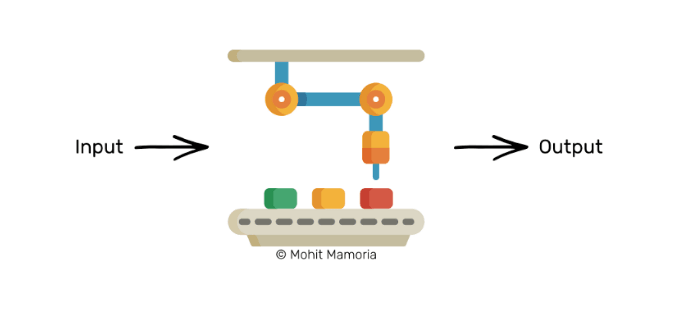
The Magic Machine (aka Hashing Function)Suppose, you send the number 4 inside it from the left, we’d find that it spat out the following word on its right: ‘dcbea.’How did it convert the number 4 to this word? No one knows. Moreover, it is an irreversible process. Given the word, ‘dcbea,’ it is impossible to tell what the machine was fed on the left. But every time you’d feed the number 4 to the machine, it will always spit out the same word, ‘dcbea.’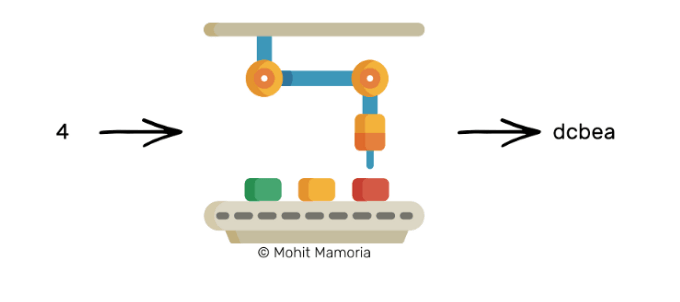
hash(4) == dcbeaGiven the word, ‘dcbea,’ it is impossible to tell what the machine was fed on the left. But every time you’d feed the number 4 to the machine, it will always spit out the same word, ‘dcbea.’Let’s try sending in a different number. How about 26?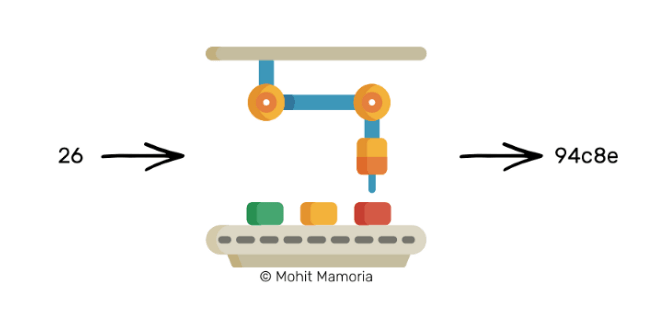
hash(26) == 94c8eWe got ‘94c8e’ this time. Interesting! So, the words can contain the numbers too.What if I ask you the following question now:“Can you tell me what should I send from the left side of the machine such that I get a word that starts with three leading zeroes from the right side of it? For example, 000ab or 00098 or 000fa or anything among the others.”
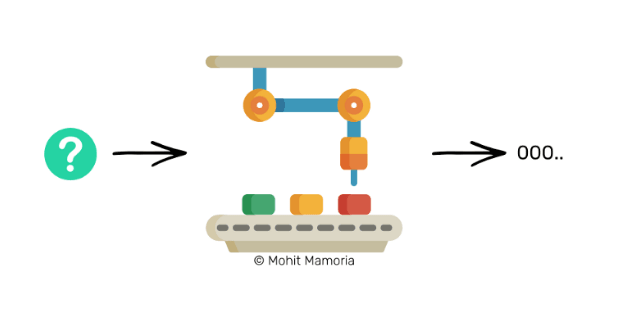
Predicting the input
Think about the question for a moment.I’ve told you the machine has a property that we cannot calculate what we must send from the left after we’re given the expected output on the right. With such a machine given to us, how can we answer the question I asked?I can think of one method. Why not try every number in the universe one by one until we get a word that starts with three leading zeroes? *Tries everything to calculate the input*Being optimistic, after several thousand attempts, we’ll end up with a number that will yield the required output on the right.
*Tries everything to calculate the input*Being optimistic, after several thousand attempts, we’ll end up with a number that will yield the required output on the right.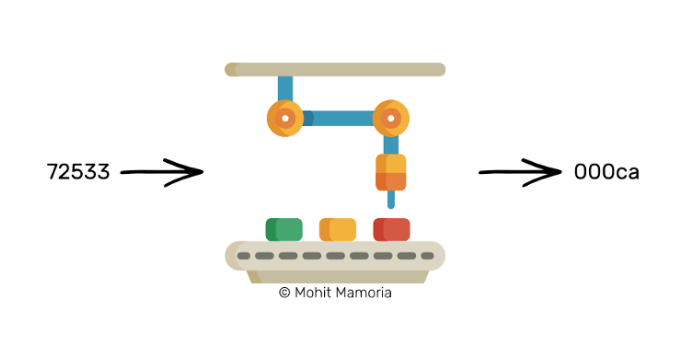
It was extremely difficult to calculate the input given the output. But at the same time, it will always be incredibly easy to verify if the predicted input yields the required output. Remember that the machine spits out the same word for a number every time.
How difficult do you think the answer is if I give you a number, say 72533, and ask you the question, “Does this number, when fed into the machine, yield a word that starts with three leading zeroes?”
All you need to do is, throw the number in the machine and see what did you get on the right side of it. That’s it.The most important property of such machines is that — “Given an output, it is extremely difficult to calculate the input, but given the input and the output, it is pretty easy to verify if the input leads to the output.”We’ll remember this one property of the Magic Machines (or Hash Functions) through the rest of the post:Given an output, it is extremely difficult to calculate the input, but given an input and output, it is pretty easy to verify if the input leads to the output.
How to use these machines to seal a page?
We’ll use this magic machine to generate a seal for our page. Like always, we’ll start with an imaginary situation.Imagine I give you two boxes. The first box contains the number 20893. I, then, ask you, “Can you figure out a number that when added to the number in the first box and fed to the machine will give us a word that starts with three leading zeroes?”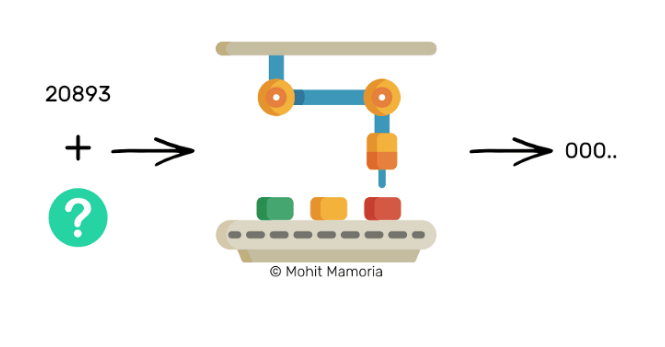
This is a similar situation as we saw previously and we have learned that the only way to calculate such a number is by trying every number available in the entire universe.After several thousand attempts, we’ll stumble upon a number, say 21191, which when added to 20893 (i.e. 21191 + 20893 = 42084) and fed to the machine, will yield a word that satisfies our requirements.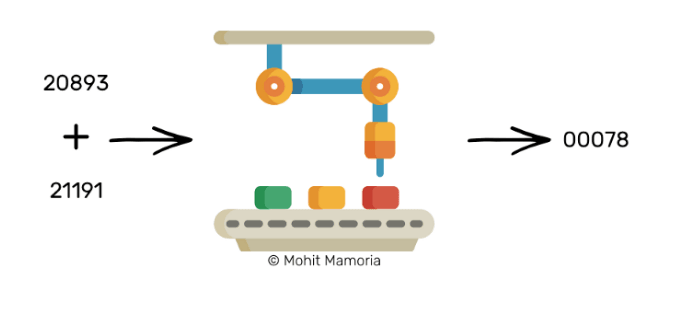 In such a case, this number, 21191 becomes the seal for the number 20893. Assume there is a page that bears the number 20893 written on it. To seal that page (i.e. no one can change the contents of it), we will put a badge labeled ‘21191’ on top of it. As soon as the sealing number (i.e. 21191) is stuck on the page, the page is sealed.
In such a case, this number, 21191 becomes the seal for the number 20893. Assume there is a page that bears the number 20893 written on it. To seal that page (i.e. no one can change the contents of it), we will put a badge labeled ‘21191’ on top of it. As soon as the sealing number (i.e. 21191) is stuck on the page, the page is sealed.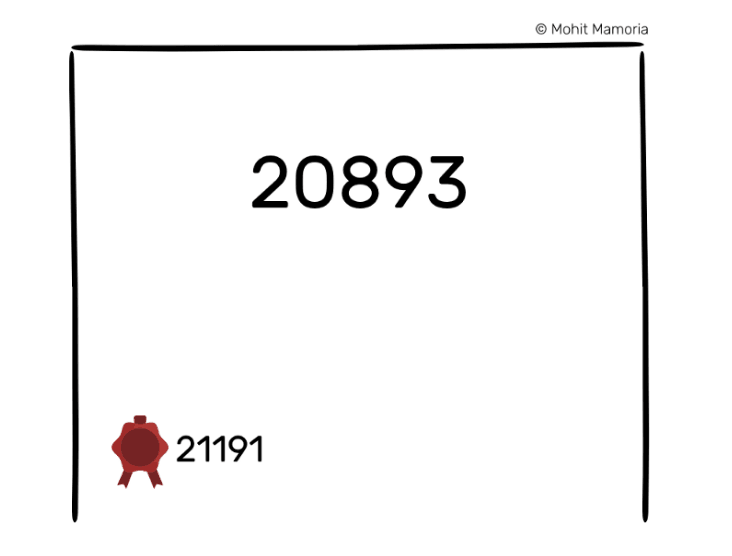
The sealed number[Jargon Box] The sealing number is called ‘Proof Of Work,’ meaning that this number is the proof that efforts had been made to calculate it. We are good with calling it ‘sealing number’ for our purposes.
If anyone wants to verify whether the page was altered, all he would have to do is — add the contents of the page with the sealing number and feed to the magic machine. If the machine gives out a word with three leading zeroes, the contents were untouched.
If the word that comes out doesn’t meet our requirements, we can throw away the page because its contents were compromised, and are of no use.We’ll use a similar sealing mechanism to seal all our pages and eventually arrange them in our respective folders.Finally, sealing our page…
To seal our page that contains the transactions of the network, we’ll need to figure out a number that when appended to the list of transactions and fed to the machine, we get a word that starts with three leading zeroes on the right.
Once that number is calculated after spending time and electricity on the machine, the page is sealed with that number. If ever, someone tries to change the contents of the page, the sealing number will allow anyone to verify the integrity of the page. Now that we know about sealing the page, we will go back to the time when we had finished writing the tenth transaction on the page, and we ran out of space to write more.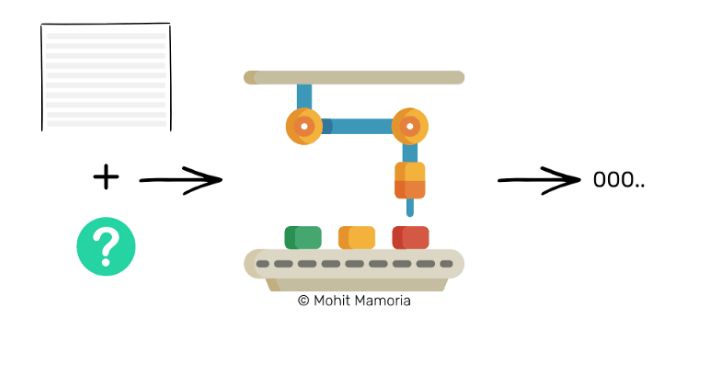
Note: I have been using the phrase ‘word starting with three leading zeroes’ only as an example. It illustrates how Hashing Functions work. The real challenges are much more complicated than this.
As soon as everyone runs out of the page to write further transactions, they indulge in calculating the sealing number for the page so that it can be tucked away in the folder. Everyone in the network does the calculation. The first one in the network to figure out the sealing number announces it to everyone else.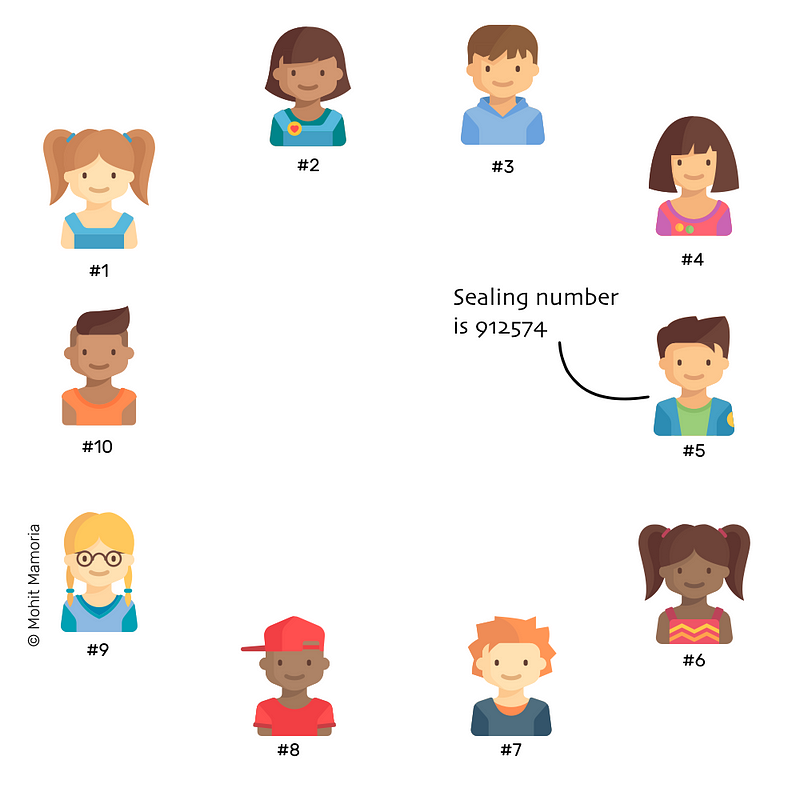
Immediately on hearing the sealing number, everyone verifies if it yields the required output or not. If it does, everyone labels their pages with this number and put it away in their folders.But what if for someone, say #7, the sealing number that was announced doesn’t yield the required output? Such cases are not unusual. The possible reasons for this could be:- He might have misheard the transactions that were announced in the network
- He might have miswritten the transactions that were announced in the network
- He might have tried to cheat or be dishonest when writing transactions, either to favor himself or someone else in the network
No matter what the reason is, #7 has only one choice — to discard his page and copy it from someone else so that he too can put it in the folder. Unless he doesn’t put his page in the folder, he cannot continue writing further transactions, thus, forbidding him to be part of the network.Whatever sealing number the majority agrees upon, becomes the honest sealing number.
Then why does everyone spend resources doing the calculation when they know that someone else will calculate and announce it to them? Why not sit idle and wait for the announcement?Great question. This is where the incentives come in the picture. Everyone who is the part of the Blockchain is eligible for rewards. The first one to calculate the sealing number gets rewarded with free money for his efforts (i.e. expended CPU power and electricity).
Simply imagine, if #5 calculates the sealing number of a page, he gets rewarded with some free money, say $1, that gets minted out of thin air. In other words, the account balance of #5 gets incremented with $1 without decreasing anyone else’s account balance. That’s how Bitcoin got into existence. It was the first currency to be transacted on a Blockchain (i.e. distributed registers). And in return, to keep the efforts going on in the network, people were awarded Bitcoins.
When enough people possess Bitcoins, they grow in value, making other people want Bitcoins; making Bitcoins grow in value even further; making even more people wanting Bitcoins; making them grow in value even further; and so on.The rewards make everyone keep working in the network.
And once everyone tucks away the page in their folders, they bring out a new blank page and repeat the whole process all over again — doing it forever.[Jargon Box] Think of a single page as a Block of transactions and the folder as the Chain of pages (Blocks), therefore, turning it into a Blockchain.
And that, my friends, is how Blockchain works.Except that there’s one tiny thing I didn’t tell you. Yet.Imagine there are five pages in the folder already — all sealed with a sealing number. What if I go back to the second page and modify a transaction to favor myself? The sealing number will let anyone detect the inconsistency in the transactions, right?
What if I go ahead and calculate a new sealing number too for the modified transactions and label the page with that instead?To prevent this problem of someone going back and modifying a page (Block) as well as the sealing number, there’s a little twist to how a sealing number is calculated.Protecting modifications to the sealing numbers
Remember how I told you that I had given you two boxes — one containing the number 20893 and another empty for you to calculate? In reality, to calculate the sealing number in a Blockchain, instead of two boxes, there are three — two pre-filled and one to be calculated. And when the contents of all those three boxes are added and fed to the machine, the answer that comes out from the right side must satisfy the required conditions.
We already know that one box contains the list of transactions and one box will contain the sealing number. The third box contains the output of the magic machine for the previous page.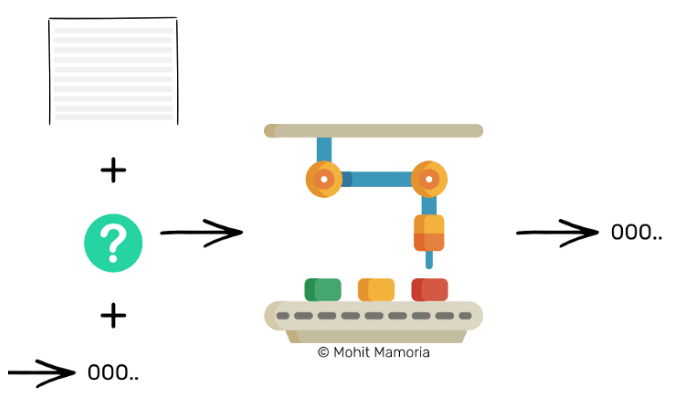
With this neat little trick, we have made sure that every page depends on its previous page. Therefore, if someone has to modify a historical page, he would also have to change the contents and the sealing number of all the pages after that, to keep the chain consistent.If one individual, out of the ten we imagined in the beginning, tries to cheat and modify the contents of the Blockchain (the folder containing the pages with the list of transactions), he would have to adjust several pages and also calculate the new sealing numbers for all those pages.
We know how difficult it is to calculate the sealing numbers. Therefore, one dishonest guy in the network cannot beat the nine honest guys.What will happen is...continue reading:
https://thenextweb.com/evergreen/2017/07/04/ultimate-3500-word-plain-english-guide-blockchain/#.tnw_...-
By
 Admin
Admin - 0 comments
- 0 likes
- Like
- Share

















